Szhahn Brand 2017 New Product Design Difference Function
UX design roles are confusing. You might know what a "UX designer" does, but what about a "visual designer", "product designer" or "UX unicorn"? Well, worry no more, because we'll put an end to any confusion you may have. Here, we'll analyze 6 common UX roles through how they contribute to the design process, and shine a light through the fog of UX roles. Soon, you'll have a clear understanding of which job role is best for you to aim for.
We designers seem to be inventing new job titles each year to describe vaguely overlapping roles, so it's not a surprise if you're feeling lost! The thing is, though, it's essential for you to understand the different UX roles. Because if you want to get your first UX job, or make a switch in your UX career, you need to have a good idea of the UX role you'd like to take on. After all, if you're unclear about your destination (i.e., the UX role you aspire to), then you cannot take steps to get there. For instance, you cannot create your UX portfolio without first knowing which UX role you want to target. Likewise, you need to know which job role you're aiming for in order to sign up for courses that can teach you those exact skills and knowledge.
Let's Navigate the Confusing Sea of Job Titles
Kate Conrick, a designer working for the Australian government, aptly summed up the confusing state of UX roles with charming humor:
"I built on my background in tech and design, picked up some solid research skills, added some business process and a sprinkle of marketing, and voila! A user experience designer. Or a service designer? A UX researcher? A digital strategist? An experience analyst? Design thinker? Stuff tinkerer? Unicorn? Power ranger? You tell me. Because I'm not sure I know the answer."—Kate Conrick
So, if you're confused about UX roles, you're not alone. But don't worry. We'll act as a compass to help you navigate the confusing sea of job titles. Here, we'll go through six of the most common UX roles:
- UX designer;
- Product designer;
- Visual designer;
- UX researcher;
- Content strategist; and
- UX unicorn (yes, we're not kidding about this job title!).
For each role, we'll describe the common tasks and deliverables, as well as give you a rough idea of whether you'll like the role. Ready to make sense of UX roles?
UX Roles Exist to Serve the Design Process
So, how do we make sense of this mess?
The first step is to realize that all UX roles exist to serve the design process. So, a great way for us to understand them is to examine how they contribute to the design process. We perform a whole slew of UX tasks as we go through a design process to create a final design. For instance, we usually start with gaining a deep understanding of users before we go on to create designs and test them with users. Different UX roles simply take charge of different subsets of these UX tasks.
We'll use the design thinking process from here onwards to illustrate our points, but we could have used any iterative design process to make our points. Almost all UX design processes share the same phases, even though some might differ slightly from one another.
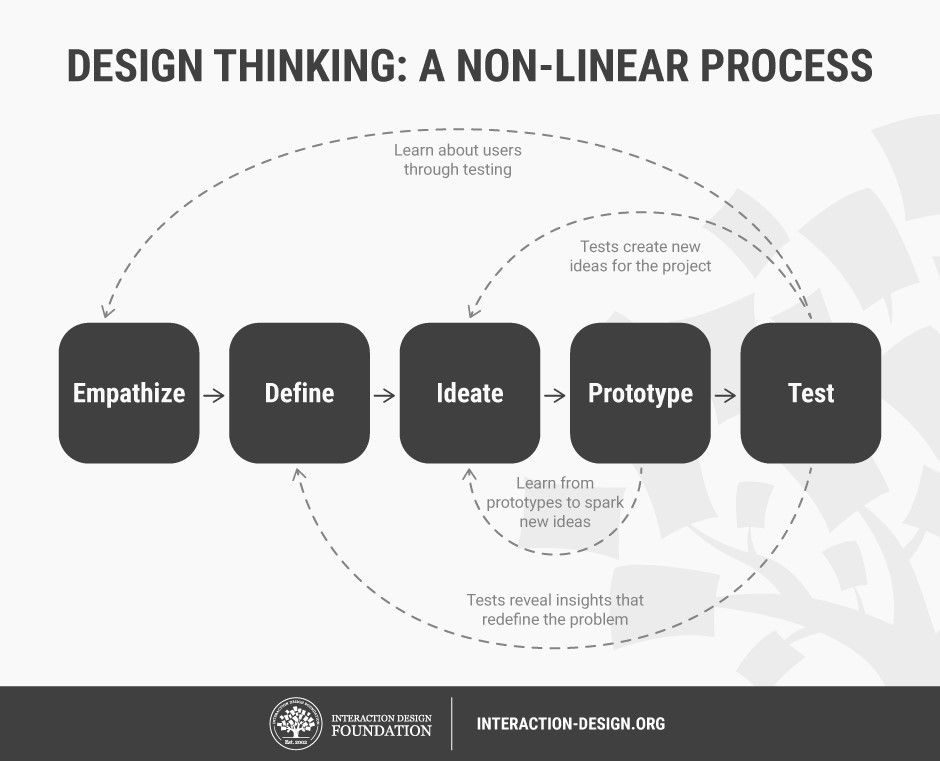
UX roles are created to fill different parts of the design process. As you can see, the stages are closely connected; they overlap and are iterative by nature, and that's partly why job roles are often so difficult to define and separate completely.
© Teo Yu Siang and the Interaction Design Foundation. CC BY-NC-SA 3.0
As you can see, the design process involves 5 phases that feed into one another:
- Empathize: where you learn about your users;
- Define: where you identify problems and user needs;
- Ideate: where you generate design ideas to solve the problems;
- Prototype: where you create mock-ups and, eventually, the final product; and
- Test: where you test your designs with users to improve them.
Let's take a look at some of the key UX tasks we perform in each of the phases:
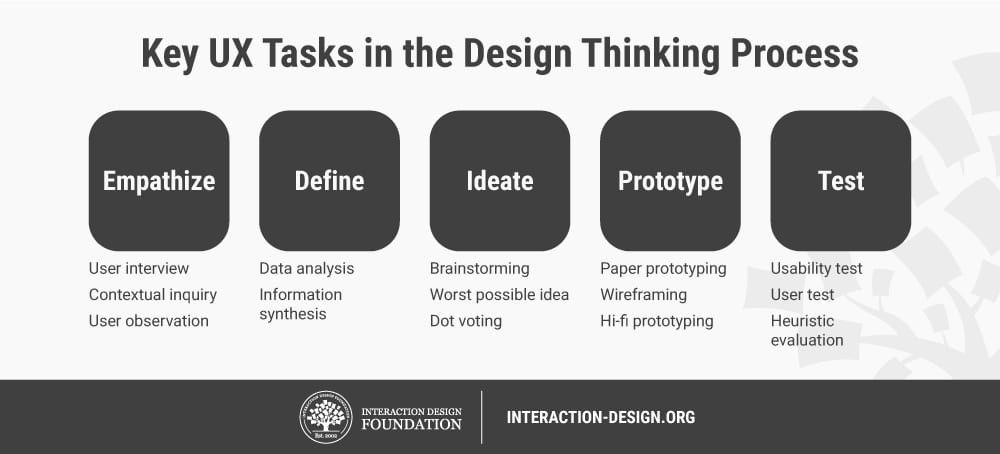
Each UX role takes charge of a different range of key UX tasks, depending on what phase(s) of the design process they handle.
© Teo Yu Siang and the Interaction Design Foundation. CC BY-NC-SA 3.0
Each UX role we'll examine below will perform a slightly different range of these key UX tasks. For instance, a UX designer is a generalist who takes charge of all the UX tasks, while a visual designer focuses on the prototype phase and creates pleasing and useful interfaces.
Why do we go through this seemingly roundabout way to understand UX roles? Well, it's because it's important to see the big picture—this way, when a new job title pops up, you'll be able to understand it in the context of the design process. On top of that, companies might define UX roles differently, but once you understand UX roles as "how they contribute to the design process", you'll be less confused when you go job-hunting and portfolio-building. In other words, this is the map that will help you navigate the different UX roles.
Enough talk; let's sail through the 6 most common UX roles!
What Is a UX Designer?
UX designers are generalists who cover a little of everything in the entire design process. As a UX designer, you'll understand your users' needs, generate ideas to solve their problems, prototype designs and finally test them with users. In other words, UX designers participate in all 5 phases of the design thinking process.
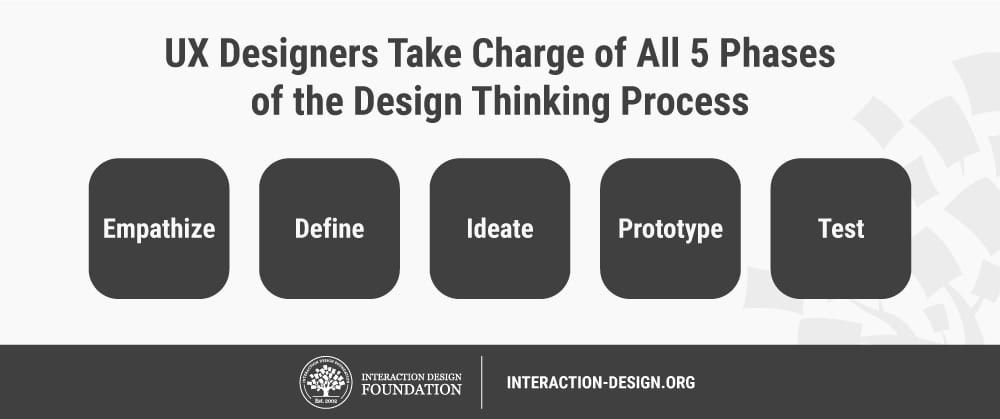
UX designers contribute towards all parts of the design process.
© Teo Yu Siang and the Interaction Design Foundation. CC BY-NC-SA 3.0
In large companies, a UX designer typically works with other designers such as UX researchers and visual designers. In smaller companies such as start-ups, UX designers tend to handle all the design work.
UX Designers Are Also Known As…
- Interaction Designers;
- UI/UX Designers; and
- Experience Designers.
What Tasks Will You Perform as a UX Designer?
As you would imagine, a UX designer conducts all kinds of UX activities to perform their job well. As a UX designer you would:
- Conduct user research through interviews, observations and other research methods;
- Analyze and identify pain points from the users' perspective, based on your user research;
- Generate ideas through ideation techniques such as brainstorming and worst possible idea to solve the users' needs in a way that provides value to the company;
- Select the most promising idea(s) based on their feasibility, desirability and viability, among other criteria;
- Prototype designs, which can range from simple paper sketches to high-fidelity and interactive digital mock-ups;
- Provide and solicit critique on your designs as well as the designs of your team-mates;
- Conduct usability and user tests to determine if your design(s) can be further improved; and ultimately
- Push a design solution out into the world that will benefit both your company and your users.
What UX Deliverables Will You Produce as a UX Designer?
While each company—and indeed, each team within a company—expects different deliverables from a UX designer, the most common ones are:
- User research reports;
- User personas;
- User journey maps;
- "How might we" statements, which capture a problem that your design aims to solve;
- Paper prototypes;
- Wireframes;
- High-fidelity, pixel-perfect mock-ups;
- Usability reports;
- Heuristic evaluation reports;
- User testing reports; and
- Design pattern libraries, style guides or design systems.
You'll Love Being a UX Designer If You…
- Enjoy taking charge of the entire design process, from the initial stage of understanding users to the final stage of producing a high-fidelity prototype;
- Have sufficient understanding of broad topics in UX, such as information architecture, psychology, emotional design, interaction design and visual design;
- Find it fulfilling to analyze complex data to produce design goals that you then work towards;
- Love to create intuitive and useful solutions to solve the problems users face in their lives; and
- Can perform—to a proficient level—a broad range of tasks from user research to designing prototypes.
Courses That Help You Become a Great UX Designer
- Become a UX Designer from Scratch
- Design Thinking: The Beginner's Guide
- User Research – Methods and Best Practices
- Accessibility: How to Design for All
- Mobile User Experience (UX) Design
- Conducting Usability Testing
- UI Design Patterns for Successful Software
What Is a Product Designer?
The product designer role is relatively new and overlaps in many ways with the UX designer role. However, a key distinction is that, as its name suggests, a product designer pays special attention to the product, on top of the user's experience.
This means as a product designer, you help create the product's designs as well as the product goals and roadmap. A product roadmap is essentially a high-level summary of the future direction of the product's offerings and features. While all UX designers consider business goals when they design experiences for users, product designers must consider not only today's business goals but also those of the long term. Product designers tend to also focus on ensuring that their designs get implemented well and on time—while UX designers should of course care about this too, it isn't exactly their role to ensure the timely delivery of new designs.
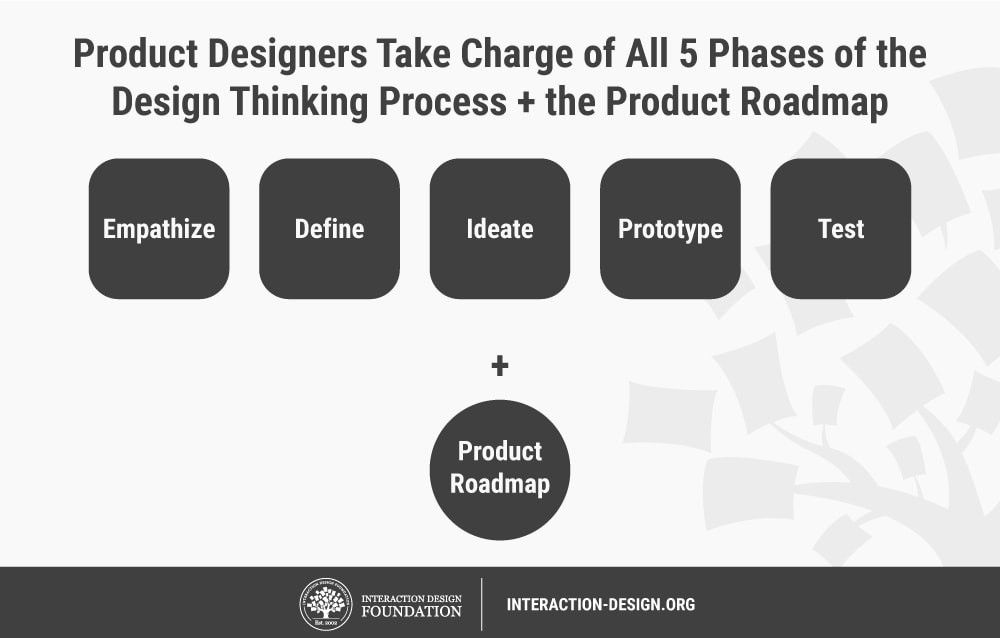
Product designers not only take charge of all phases of the design thinking process; they also help shape the product roadmap.
© Teo Yu Siang and the Interaction Design Foundation. CC BY-NC-SA 3.0
Product Designers Are Also Known As…
There aren't really any synonyms for product designers, although some companies define product designers as identical to UX designers. Other companies view product designers as senior UX designers who have the added responsibility of charting a product's goals and roadmap.
What Tasks Will You Perform as a Product Designer?
- All tasks mentioned under "UX designer" above;
- Inform and plan the product's roadmap 6–12 months into the future; and
- Collaborate closely with development and marketing teams to ensure that designs can be successfully implemented.
What UX Deliverables Will You Produce as a Product Designer?
- All deliverables mentioned under "UX designer" above; and
- Product roadmaps (which you will likely co-develop with other stakeholders such as team leaders, the product manager and/or the CEO).
You'll Love Being a Product Designer If You…
- Enjoy developing and integrating business goals into design and product decisions;
- Love participating in the entire design process;
- Possess deep knowledge in design and a good understanding of business; and
- Can analyze complex data to synthesize designs that satisfy business goals and user needs.
Courses That Help You Become a Great Product Designer
- Become a UX Designer from Scratch
- Design Thinking: The Beginner's Guide
- User Research – Methods and Best Practices
- Accessibility: How to Design for All
- Mobile User Experience (UX) Design
- Conducting Usability Testing
- UI Design Patterns for Successful Software
- UX Management: Strategy and Tactics
What Is a Visual Designer?
Unlike a UX or product designer, a visual designer is a specialist. As a visual designer, you focus on creating pixel-perfect prototypes that are consistent with the rest of the product. In this sense, visual designers focus on the later phases of the design process, and in particular the prototype phase.
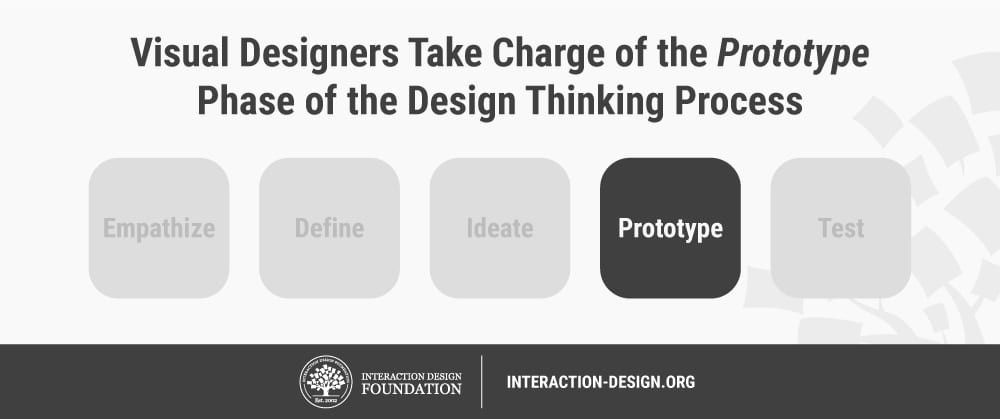
Visual designers are specialists who focus on the prototype phase of the design process.
© Teo Yu Siang and the Interaction Design Foundation. CC BY-NC-SA 3.0
Visual Designers Are Also Known As…
- UI Designers; and
- Graphic Designers.
What Tasks Will You Perform as a Visual Designer?
As a visual designer, you would:
- Transform UX goals—e.g., let a user sign up for an account successfully—into a set of beautiful, easy-to-use and accessible designs, such as a set of app screens;
- Create and/or maintain a library of icons, colors and fonts that will be used throughout the product;
- Apply branding guidelines into your designs in a way that serves both the brand and your users; and
- Use your knowledge of typography, color theory, Gestalt principles and other design concepts to create pleasant graphical user interfaces.
What UX Deliverables Will You Produce as a Visual Designer?
Some common deliverables you'll produce as a visual designer include:
- Pixel-perfect prototypes;
- Interactive prototypes;
- Visual style guides;
- Icon libraries;
- Design specifications, so your frontend developer team-mate can produce the live code needed to implement it; and
- Branding materials or guidelines that supplement the product.
You'll Love Being a Visual Designer If You…
- Love working on creating visual, pixel-perfect mock-ups of a product;
- Have a deep knowledge of and/or passion for typography, color, use of space and other graphic design concepts; and
- Are great at applying consistent, meaningful and pleasing visuals across a wide range of user flows and contexts.
Courses That Help You Become a Great Visual Designer
- UI Design Patterns for Successful Software
- Gestalt Psychology and Web Design: The Ultimate Guide
- Design Thinking: The Beginner's Guide
- The Practical Guide to Usability
- Information Visualization
- Accessibility: How to Design for All
- Mobile User Experience (UX) Design
- The Ultimate Guide to Visual Perception and Design
What Is a UX Researcher?
Just like a visual designer, a UX researcher is a specialist. UX researchers use qualitative and quantitative user research methods to provide real user information which other designers then use to inform their designs. As a UX researcher, you'll take part in the first phases of the design process. You'll empathize with users to gain a holistic understanding of their needs and help define the problems that the product should solve. UX researchers also take part in the testing phase and help validate and improve designs.

UX researchers are specialists whose findings will influence the empathize, define and test phases of the design process.
© Teo Yu Siang and the Interaction Design Foundation. CC BY-NC-SA 3.0
UX Researchers Are Also Known As…
- User Researchers; and
- Researchers.
What Tasks Will You Perform as a UX Researcher?
If you're a UX researcher, you'll be doing these tasks:
- Gain a rich and full understanding of users through qualitative user research methods such as user interviews, user observations and field studies;
- Piece together a realistic (and even statistically significant) understanding of specific traits of users by conducting quantitative user research, using such methods as surveys and card sorting;
- Analyze the data you've gathered on users to synthesize key findings and make design proposals;
- Advocate for users' needs and perspectives towards various internal stakeholders, such as other designers, developers, marketers and executives;
- Help inform product goals by presenting your research findings to other designers, developers and marketers in your company; and
- Test and improve designs by conducting evaluative research, such as usability and user testing.
What UX Deliverables Will You Produce as a UX Researcher?
These are the main deliverables you'll create as a UX researcher:
- User research reports (for a range of qualitative and quantitative research methods);
- User personas;
- User stories;
- User journey maps;
- "How might we" statements;
- Usability reports;
- Heuristic evaluation reports; and
- User testing reports.
You'll Love Being a UX Researcher If You…
- Have a strong passion for human psychology and the study of people;
- Enjoy stepping into the shoes of others to empathize with them and piece together a rich and deep picture of their perspectives and problems;
- Are well-versed in psychology or interested in learning deeply about it; and
- Love generating and analyzing complex qualitative and quantitative data.
Courses That Help You Become a Great UX Researcher
- User Research – Methods and Best Practices
- Conducting Usability Testing
- Design Thinking: The Beginner's Guide
- The Practical Guide to Usability
- Accessibility: How to Design for All
What Is a Content Strategist?
Content strategists play a role in a critical area that we often overlook as designers: words. Copy is one of the most important parts of a design, so we should not be surprised to find a role specifically targeted at copywriting. As a content strategist, you'll contribute to the prototype phase of the design process, and you are crucial in finalizing the product before launch.
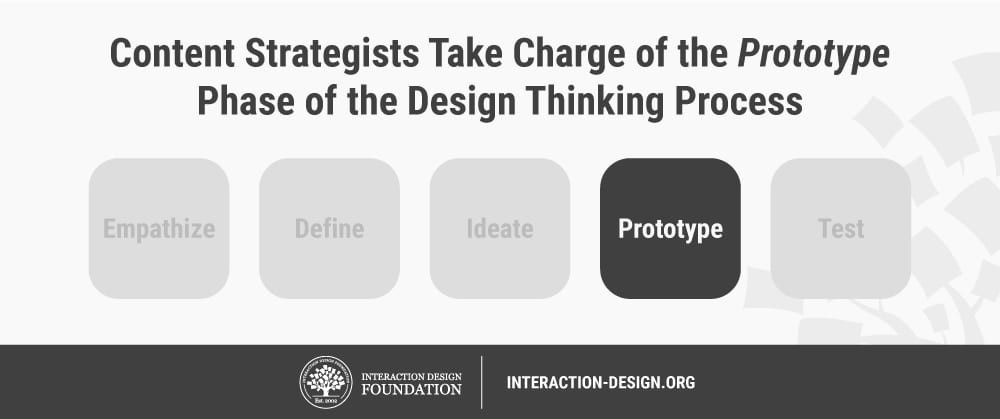
Content strategists are specialists who craft the right copy for use in the prototype phase of the design thinking process.
© Teo Yu Siang and the Interaction Design Foundation. CC BY-NC-SA 3.0
Content Strategists Are Also Known As…
- Copywriters; and
- UX Writers.
What Tasks Will You Perform as a Content Strategist?
You'll write effective copy for your product, for instance:
- Write copy for user interfaces so that people can navigate, use and troubleshoot the product easily;
- Create effective page titles and navigation menu item names so that users can intuitively get to the page or screen they want;
- Write error messages that are simple, effective and blame-free; so, in the unfortunate event of an error, users feel assured rather than annoyed;
- Craft effective emails and newsletters to achieve product goals (such as to get people to sign up for an account);
- Weave a cohesive narrative throughout the product, so users will experience a consistent tone of voice and direction no matter which screen or page they access; and
- Define and maintain a vision for the product's language that will be applied across the board.
What UX Deliverables Will You Produce as a Content Strategist?
As a content strategist, you'll find that most of your work will be directly applied to the product and thus will not appear as a standalone deliverable. Therefore, your most common deliverables are:
- Copy, which you will incorporate into the product itself; and
- Editorial guidelines or product language guidelines that set the tone and content style for the product.
You'll Love Being a Content Strategist If You…
- Love to help users achieve their goals with the least cognitive load. That means you should be attracted to empathizing with your users and understanding their goals;
- Likewise, you're passionate about achieving your product's and business's goals;
- Possess deep knowledge in writing as well as a solid understanding of UX design; and
- Enjoy using empathy, data, business goals and logic to inform your writing.
Courses That Help You Become a Great Content Strategist
- User Experience: The Beginner's Guide
- Accessibility: How to Design for All
- The Practical Guide to Usability
Okay, What Exactly Is a UX Unicorn?!
In the world of tech start-ups, the word "unicorn" refers to someone who possesses not only the usual set of skills required for a role but also additional skills in another domain. These additional skills multiply the amount of value they contribute to a business—hence the legendary name. A UX unicorn typically refers to a UX designer who's proficient in design and front-end development.
UX unicorns are extremely rare—only people talented enough to do real frontend work are considered proper UX unicorns. UX unicorns thus take charge of the entire design process, and more—they also translate their designs into live code.
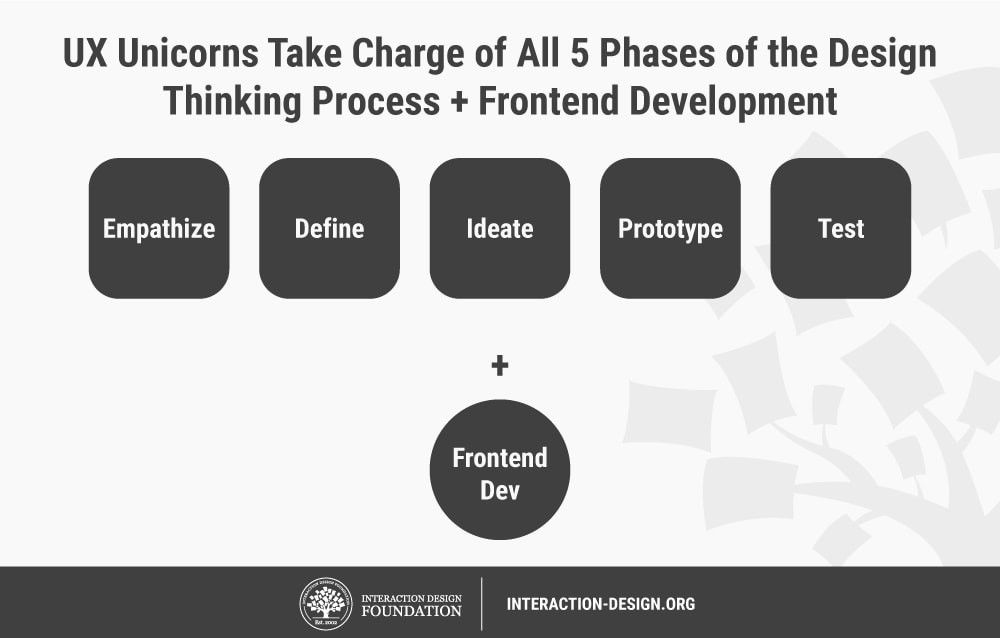
UX unicorns are a rare and special breed of people who can not only contribute to all phases of the design process; they can also take charge of frontend development.
© Teo Yu Siang and the Interaction Design Foundation. CC BY-NC-SA 3.0
UX Unicorns Are Also Known As…
- UX Engineers.
What Tasks Will You Perform as a UX Unicorn?
- All tasks mentioned under "UX designer" above;
- Develop live frontend prototypes, which you can use to test on users for more realistic results; and
- Implement the front-end code of a design.
What UX Deliverables Will You Produce as a UX Unicorn?
- All deliverables mentioned under "UX designer" above;
- Frontend prototypes; and
- Frontend code that is ready for launch.
You'll Love Being a UX Unicorn If You…
Well, to be honest, the UX unicorn isn't something most people can realistically strive towards. It simply takes too much time to be proficient in UX design and front-end coding. This is the sort of phenomenon that comes from, for instance, having been an active hobbyist for years. If you've got a strong passion for and deep knowledge of front-end development, you might find this role a viable option. However, we recommend that you aim for the 5 other UX roles we've covered above.
Courses That Help You Become a Great UX Unicorn
- Become a UX Designer from Scratch
- Design Thinking: The Beginner's Guide
- User Research – Methods and Best Practices
- Accessibility: How to Design for All
- Mobile User Experience (UX) Design
- Conducting Usability Testing
- UI Design Patterns for Successful Software
- Dynamic User Experience: Design and Usability
So, Which Role Should You Go For?
Now that we've gone through the 6 main UX roles, you should have a much clearer idea of the one that appeals the most to you.
If you cannot decide whether to be a generalist UX designer or to specialize, Stephen Gay's advice might help you. Stephen Gay is the UX Lead of Google AdWords, and he recommends that you choose your design role based on your passion and skills.
Video copyright info
© The Interaction Design Foundation, CC BY-SA-NC 3.0.
Stephen Gay suggests that you play to your passions and strengths when you decide whether to be a generalist or specialist designer. Author / copyright holder: The Interaction Design Foundation. Copyright terms and license: CC BY-SA-NC 3.0.
If you're still unsure, we recommend that you go for the UX designer role. You'll then get to experience the different specializations; if you come to like one of them especially, you can then dive into that one.
Remember That UX Roles Are Ever-Changing
Our final word of advice: UX roles are in flux—and we predict that they always will be. After all, we designers seem to have a limitless amount of creativity that makes us reinvent and redefine roles every few years.
Thankfully, you now possess a map to navigate the sea of UX roles! When you know how UX roles exist to fill gaps in the design process, you'll emerge clear-headed no matter how chaotic the field seems.
When you go job-hunting, remember that different companies might define roles differently, too! Large companies, for instance, tend to hire specialist designers, so they often have specific roles such as "User Researcher" and "Visual Designer". Small and medium-sized companies, on the other hand, tend to prefer generalists and will have roles such as "UX Designer" or even "UI/UX Designer". Always carefully read the job description of an opening before you apply, and make sure it's a role that you are able and willing to perform.
The Take Away
UX roles sound confusing and overlap in some ways, but all exist to serve different parts of the design process. A great way to understand UX roles is to identify which phases of the design process they contribute towards.
Here's a quick summary of the 6 common UX roles:
- UX designers take charge of the whole design process and work on all 5 phases of the design thinking process;
- Product designers are like UX designers, but additionally, help to chart a vision of the product's mid-to-long-term roadmap;
- Visual designers specialize in the prototype phase and create pleasant, useful and usable interfaces and visuals;
- UX researchers focus on understanding and advocating for users, and take part in the empathize, define and test phases;
- Content strategists are all about crafting pieces of copy that are persuasive, clear and consistent, and contribute towards the prototype phase;
- Lastly, UX unicorns are rare people who handle both UX design and frontend development.
We recommend that you aim for a design job that matches your passion and skills. If that's hard to determine just yet, we advise you to go for the broad UX designer role and then narrow down your focus as you find out what you love doing.
"The only way to be truly satisfied is to do what you believe is great work, and the only way to do great work is to love what you do. If you haven't found it yet, keep looking, and don't settle. As with all matters of the heart, you'll know when you find it."—Steve Jobs
References and Where to Learn More
Kate Conrick's thought-provoking article on UX roles, aptly titled "We need to talk about UX roles", can be read here: https://uxdesign.cc/guys-we-need-to-talk-about-ux-roles-bf86a003f642
Szhahn Brand 2017 New Product Design Difference Function
Source: https://www.interaction-design.org/literature/topics/product-design
0 Response to "Szhahn Brand 2017 New Product Design Difference Function"
Post a Comment